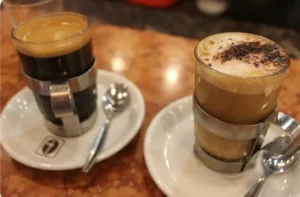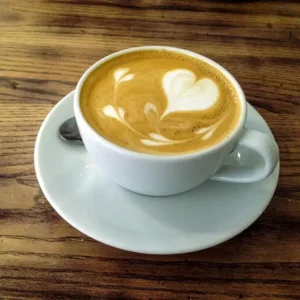
When it comes to coffee, you may be wondering what the difference is between a cortado and a latte. These two drinks have very similar characteristics and many people mistakenly confuse them. This article will help you understand the differences between these two drinks so you can choose the right one for you.
What is a Cortado?

A cortado and a latte are two types of espresso coffees. They both contain a shot of espresso and steamed milk. A cortado contains no or very little foam, while a latte usually has a solid layer of microfoam. While they may have the same ingredients, they are significantly different drinks.
While the Cortado is usually served without milk, there are versions of it that are made with milk. These coffee drinks are usually served in a glass and have been around for decades. Some places even offer versions with other types of milk or condensed milk.
A cortado has a stronger coffee flavor than a latte, while a latte is milkier. They are both made with the same amount of coffee and milk, but the Cortado contains one or two espresso shots, while the Latte contains more milk. A cortado is usually served in a glass tumbler, while a latte is served in a mug and is milkier in color.
A cortado has less milk than a latte, which makes it more expensive. However, cortados are generally served in smaller cups and contain equal parts espresso and steamed milk, unlike latte, which is steamed milk without a milky finish.
What is a Latte?

A latte is a popular drink. It originated in Italy, but it has also been popular throughout Europe, Britain, and the United States. It is traditionally made with a double shot of espresso and steamed milk. This beverage also features a layer of milk foam on top. The drink has been attributed to Lino Meiorin, but the origins of the drink aren’t certain.
The word “latte” comes from the Italian word “caffe e latte,” which literally means “coffee and milk.” Although this term isn’t very descriptive of the drink, it’s a good way to remember that the drink is a coffee and milk blend. The drink became popular in the English-speaking world after World War II. Despite its Italian name, the drink didn’t start appearing on the menus of Italian and French coffee shops until the 20th century.
The most common type of Latte is a Caffe Latte. However, other beverages can be substituted for espresso, including matcha, chai, or mate. Some cafes also have alternatives for people with lactose-intolerant or other dietary needs. For example, Pacific Barista sells specially formulated milk alternatives such as rice milk and hemp milk. These milks contain micro-foaming agents and are great for creating rich, frothy drinks.
Difference Between Cortado vs Latte?
While cortados are similar to a latte, they are two very different drinks. Cortados are made from espresso and milk, while latte is a coffee made with hot water. The difference between cortado and latte is mainly in the amount of milk, which is not as large as the amount of milk in latte.
While both coffee drinks have milk, Cortados are a healthier choice. They have a smaller cup size and have more coffee flavor than the latte. Those who enjoy a bolder, milkier drink may prefer a latte. But if you’re looking for a quick caffeine fix, the latte is the way to go.
Cortados are made with equal amounts of espresso and milk. While lattes have more milk, they both contain similar amounts of calories. A cortado with 2 ounces of espresso and 2 ounces of milk has 50 calories. On the other hand, a latte made with the same ingredients, but with different flavorings, can pack more calories. A vanilla latte made with 2 ounces of espresso and 8 ounces of steamed milk contains 190 calories.
The cortado has higher caffeine content than a latte, while the latte is smaller and has a thinner texture. The proportion of espresso to milk is also different. A small or medium latte contains about 80mg of caffeine, while a large one contains about 120mg of caffeine. The caffeine content of each depends on the type of coffee beans used and the brewing method. Darker roasts contain more caffeine than light roasts.
Similar Beverages
Cortados and lattes are both espresso-based drinks, but they are made differently. While both drinks contain caffeine, cortados usually contain more than 150 milligrams of caffeine per serving, while lattes contain as little as three milligrams. Cortados are traditionally served in a smaller glass cup with milk, whereas latte is usually served in a tall glass with more milk. Both beverages have their own distinctive flavors and textures.
Cortados have a richer coffee flavor, while lattes are sweeter. A cortado contains about one-half as much coffee as a latte, and it contains a richer, creamier foam. Latte contains about half the milk of a cortado.
While cortados are a great way to end a large meal, a latte is a healthier choice for dessert. They both contain caffeine, so they’re better for breakfast or after a big meal. But a latte is better for dinner. It’s richer, with a larger serving size and a warm sensation.
While both drink ingredients are similar, cortados contain fewer calories and are more nutritious than lattes. Both are made with espresso, although the milk used to make them differs. A cortado has 16 to 36 calories while a latte has 93+ calories.
Is cortado stronger than latte?
A cortado is a coffee drink with a high level of caffeine. It contains equal parts of espresso and steamed milk. Compared to a latte, it has a larger volume of milk and less foam. A cortado also has a stronger coffee flavor, and it blends better with steamed milk.
Both are made from espresso, but cortados are stronger. The coffee flavor in cortados is more intense than in latte, which has lower acidity and more bitterness. A latte is a much sweeter drink that uses steamed milk to dilute the espresso. It is a perfect choice if you prefer to add a little milk to your coffee. You can also add sugar or cream to either beverage to make it to your taste.
Cortados are darker and have a higher percentage of espresso than latte. They are also made in a glass tumbler, while latte is served in a mug. Both beverages are similar in terms of appearance but have different tastes.
Is a cortado 1 or 2 shots?
Cortados are an espresso drink with milk added to the mix. It is served in a small glass cup and is a great alternative for those who prefer a creamier espresso. A cortado typically contains two shots of espresso and two ounces of milk. The milk adds creaminess and balances out the bitterness of the espresso. Cortados are often served with a dash of sugar or condensed milk.
A cortado is an espresso drink made with one or two shots of espresso and roughly equal parts of steamed milk. Its name derives from the Spanish word cortar, which means “cut.” It has more milk than a cappuccino, but less than a macchiato. In some instances, baristas add even more milk to make it smoother.
Another espresso drink is called a latte. It’s not as strong as a cortado and usually contains about 1/3 espresso and two-thirds steamed milk. It is also served in a larger glass, usually six ounces or more. Its milk is also textured, and contains microfoam, allowing for the creation of latte art.
What does Starbucks call a cortado?
The word cortado is Spanish, meaning “cut.” It refers to the way the espresso is cut with steamed milk, and it is one of the most popular coffee drinks in the world. It is served in a glass known as a Gibraltar and is often decorated with latte art. Although it looks like an espresso latte, a cortado has a distinct espresso flavor and kick of caffeine that makes it a favorite drink of coffee lovers everywhere. It should be consumed slowly for maximum flavor and enjoyment.
A cortado is made with equal parts of espresso and steamed milk. It may also contain a small amount of microfoam. A latte is similar but usually contains more steamed milk and is usually topped with a solid layer of microfoam.
While cortados originated in Spain, they are now available in most coffee shops. Although they’re not on the Starbucks menu, they’re worth trying. However, not all coffee lovers know what a cortado is, and even passionate coffee enthusiasts might struggle to tell it apart from a caffe latte.







